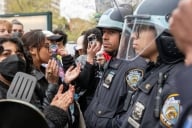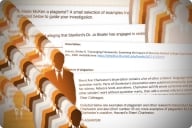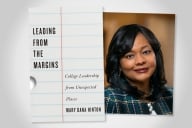You have /5 articles left.
Sign up for a free account or log in.
William F. Buckley Jr.'s 1951 book God and Man at Yale popularized a view of higher education as hostile to faith. A new book, however, The Resilience of Religion in American Higher Education (Baylor University Press), finds faith alive and well in American higher education. The authors find that resilience evident both at public and private institutions. And they find it at religious institutions with varying ideas about their missions.
To be sure, the book does not present issues of religion in American higher education as simple or without tensions. But they find "a surprising openness" to religion in academe.
The authors are John Schmalzbauer, a professor of religious studies at Missouri State University and the author of People of Faith: Religious Conviction in American Journalism and Higher Education, and Kathleen A. Mahoney, a senior staff member at the GHR Foundation and author of Catholic Higher Education in Protestant America: The Jesuits and Harvard in the Age of the University. They responded via email to questions about their new book.
Q: Many people think of religion and higher education as a topic related to religious colleges. Your book also discusses student religious life at secular institutions, many of them public. What do you see as the major trends in student religious life at these colleges?
A: Public and nonsectarian private universities are some of the most religiously diverse places in America. Since the '60s, they have witnessed an increase in the sheer variety of religious activity, reflecting the rise of campus evangelicalism, the revitalization of Jewish student life, a surge in new immigrant religions and the emergence of alternative forms of spirituality. At the same public university where Coach John Wooden and Kareem Abdul-Jabbar forged an interfaith friendship, religious diversity flourishes. Today the University of California, Los Angeles, is home to nearly 50 religious groups, including the first Campus Crusade chapter, the first Chabad House, a large Hillel building, a 54-year-old Muslim Student Association, a Coptic Orthodox Christian club, a Methodist cafe and a University Buddhist Association. Across the country, private philanthropy has supported dozens of ventures at secular institutions, including the Lilly Endowment’s recent vocation initiative and Yale University’s $75 million Roman Catholic center.
Responding to this diversity, the field of student affairs is rediscovering a more holistic understanding of student development that recognizes religious, secular and spiritual identities (the focus of two recent NASPA gatherings). A growing number of secular institutions have constructed multifaith chapels and meditation spaces, catering to both people of faith and the spiritual but not religious. A burgeoning interfaith movement has tried to connect these diverse communities, though recent findings from the IDEALS survey suggest that universities could do more to foster an inclusive climate.
Q: What is your sense about the directions of scholarship about religion at secular institutions?
A: Over the past 50 years, religion departments have proliferated at public and nonsectarian private institutions. Religion-oriented centers and institutes can be found at Columbia, Colorado, Indiana, New York University, Princeton and the University of Southern California. Most of these centers focus on “religion and” topics, exploring the role of faith in politics, health care and popular media. In the wake of the 2016 election, scholars in history, sociology and political science have investigated the roots of religious nationalism in America and around the world. While some religion scholarship is a version of “knowing your enemies” (Peter Berger’s apt expression), others have cultivated a more empathetic approach, though the current political climate has strained this capacity for scholarly empathy. In the face of resurgent racism, sexism and xenophobia, religion scholars are taking a stand.
Faculty have also turned their attention to spirituality, including senior scholars like Alexander Astin, the founding director of UCLA’s Higher Education Research Institute. Even theology is finding a place. While Duke University’s Center for Spirituality, Theology and Health helped institutionalize the field of religion and medicine, programs at Berkeley and Virginia are bringing theology back into public universities.
Q: Many Roman Catholic colleges, which have long served students and employed faculty members of a variety of faiths, have made or are making the adjustment to lay presidents. Do you see this changing their missions?
A: Filling the position of president in Catholic colleges with lay men and women instead of priests and sisters speaks less to a change in mission and more to the coming of age of the American Catholic laity. Of course, the declining number of priests and sisters in the U.S. is a factor. There’s no doubt about that. But recourse to lay presidents also demonstrates the fulfillment of mission, namely the historic commitment to prepare lay Catholics for leadership in church and society. John J. DeGioia is a great example: a graduate of Jesuit-sponsored Georgetown University, Jack assumed the presidency of his alma mater in 2001 and has become its longest-serving president.
The shift to lay leadership hasn’t been without some angst. But significant investments have been made to support lay presidents and their teams. For almost 20 years, Boston College’s Institute for Administrators in Catholic Higher Education has been working with senior leaders of Catholic colleges. Many universities have hired senior-level mission officers, recognizing that responsibility for institutional identity should not be solely vested in the person of the president. If it means anything at all, responsibility for the mission must be dispersed more widely, to the sponsoring religious order, the board, administration, faculty and staff, as well as the president.
Q: Many evangelical colleges have experienced tremendous enrollment growth in the last decade. Do you expect that to continue?
A: After decades of growth, there are signs that enrollment in evangelical colleges is already tapering off. During the Great Recession, many small religious colleges faced mounting financial problems due to tuition discounting. As Robert P. Jones notes in The End of White Christian America, white evangelicals comprise a shrinking percentage of younger age cohorts, suggesting that the market for evangelical higher education may be contracting. The key to future enrollment growth lies in the ethnic diversification of American evangelicalism. Thanks to immigration, denominations like the Assemblies of God will soon be minority majority. Colleges that diversify will thrive. Colleges identified with nativist rhetoric and anti-immigrant policies may struggle.
Q: Many evangelical colleges have been criticized for their views on sexuality (in particular ideas about gay people) and science (a belief by some that the Bible is to be taken literally, challenging ideas about evolution and so forth). Do you see those views holding back these colleges?
A: Evangelical colleges will find it increasingly difficult to maintain conservative positions on LGBT issues. According to a 2017 survey conducted by the Public Religion Research Institute, 53 percent of young white evangelicals favor legalizing same-sex marriage. Older evangelicals feel very differently about this issue. This gap will create tensions and conflicts for evangelical colleges and could further depress enrollment. Recently, the Council for Christian Colleges and Universities endorsed sexual orientation and gender identity laws that include broad religious exemptions. While such legislation could insulate CCCU institutions from legal challenges, it will not eliminate evangelicalism’s generational divide on LGBT issues.
As for religion and science, there is a wide spectrum of views on evolution. Some colleges hold to a young earth creationist position, appealing to evangelicalism’s right flank. Another set of institutions affirms the harmony of evolutionary biology and Christian theology, along the lines of the BioLogos Foundation. In the middle are places where the boundary lines are unclear, a situation that has sometimes led to the firing or resignation of science faculty. Such uncertainty makes it hard for evangelical colleges to recruit and retain scientists.
Q: During the Trump presidency, Liberty University has emerged as the president's favorite college and its president has become a consistent advocate for President Trump. How is this shaping public perceptions of religious higher education?
A: The alliance between Liberty University and the Trump administration contributes to the cynicism many Americans have about religion and public life. While such coalitions go back to the Reagan administration (and are rooted in the fraught racial history of white evangelicalism), there is a growing sense that evangelicals will do anything for political power. Because of its immense online footprint, Liberty looms large in public perceptions of Christian higher education. Yet scholars at dozens of other evangelical institutions (see, for example, the work of Kristin Kobes Du Mez, John Fea and Soong-Chan Rah) do not identify with Jerry Falwell Jr. and Franklin Graham. They are also alienated from the 81 percent of white evangelicals who voted for Trump. Many faculty have ditched the evangelical label. Others have articulated an alternative vision of evangelicalism that rejects misogyny, racism and xenophobia, though it is hard to shout louder than Falwell and Graham.








